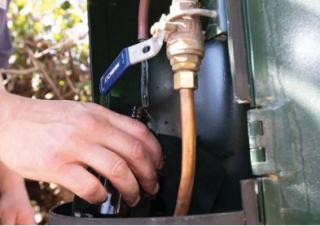Per- and Polyfluorinated Alkyl Substances (PFAS)

Per- and polyfluoroalkyl substances (PFAS) are of increasing concern to the water sector and the public. Below is an outline of what PFAS are and what the San Lorenzo Valley Water District is doing to monitoring and report PFAS in its water system.
What are PFAS?
Per- and polyfluoroalkyl substances, known as PFAS are a group thousands of man-made chemicals that resist oils, stains, heat and water. They have been widely used for several decades in consumer products such as waterproof clothing, food packaging, nonstick cookware and stain resistant fabrics. They have also been used in firefighting foams and in industrial processes.
PFAS break down very slowly and can accumulate in the environment as well as in humans and animals. Because these chemicals break down slowly, they are called “forever chemicals”. PFAS have been found worldwide in water, air, and soil. PFOA and PFOS are two common PFAS chemicals
What are the health effects of PFAS?
A wide range of scientific studies suggest a certain level of PFAS exposure can cause adverse health effects in humans. These health effects include reproductive and developmental effects, increased risk of cancer, increased cholesterol, reduced immunity, interference with natural hormones and liver damage.
How are humans exposed to PFAS?
Most people have been exposed to PFAS though consumer products but drinking water can be another exposure source. The major sources of PFAS contamination in water supplies are fire training and response sites, industrial sites, landfills and wastewater treatment plants/biosolids. Because of their persistence in the environment, PFAS can accumulate in water supplies.
Are there limits for PFAS in drinking water?
Not yet, but on March 14, 2023, the US EPA released a proposal to limit six PFAS compounds in drinking water by establishing a Maximum Contaminant Level (MCL) of 4 parts per trillion for PFOA and PFOS. This proposed regulation would also place limits on four other types of PFAS chemicals (PFNA, PFHxS, GenX, and PFBS). If this EPA rule is finalized, public water systems will need to monitor water supplies for these chemicals and ensure drinking water does not exceed these limits. This may require additional treatment or blending of water sources. For more information, please visit: https://www.epa.gov/sdwa/and-polyfluoroalkyl-substances-pfas
How can PFAS in drinking water be treated?
Treatment technologies that show to be effective in removing PFAS from drinking water include granular activated carbon, ion exchange resin beds and high-pressure membranes (such as reverse osmosis or nanofiltration). More information can be found at:
- epa.gov/sciencematters/reducing-pfas-drinking-water- treatment-technologies
- nsf.org/news/pfoa-pfos-reduction-claims-requirements- added-to-nsf-standards
Are PFAS found in bottled water?
Bottled water producers are not subject to EPA drinking water regulations. Instead, bottled water producers are regulated by the Food and Drug Administration (FDA). The FDA evaluates EPA drinking water standards and adopts bottled water standards as deemed appropriate. We recommend customers contact bottled water produces directly for information regarding water quality of their bottled water.
What is the San Lorenzo Valley Water District doing about PFAS?
In 2020, the State Water Resources Control Board- Division of Drinking Water issued PFAS monitoring orders to drinking water purveyors that had water sources within a 1 mile radius of high risk sites, such as landfills, industrial sites and airports. SLVWD’s Quail Well 4 and Quail Well 5A are within 1 mile of the Ben Lomond Transfer Station. The District began sampling both wells starting in the 4th quarter of 2020. After sampling for 4 consecutive quarters Quail Well 4 had no PFOA or PFOS detections. The Quail 5A did have detections below the respective notification levels. The District continues to sample the Quail 5A well quarterly. The most recent samples taken in May 2023 from Quail Well 5A did have detections below the notification levels. Water produced from Quail Well 5A accounted for approximately 10% of water production for the SLVWD system in 2022.
SLVWD has begun sampling all sources as a part of the Unregulated Contaminant Monitoring Rule, revision number 5 (UCMR5). UCMR5 sampling began in the 1st quarter of 2023. These samples were taken from the effluent line of our Lyon Treatment Plant. Results from these samples showed no detections. Any sample detections will be included in future Consumer Confidence Reports (CCR’s), which summarize water quality results during the calendar year.
Protecting public health and the quality of drinking water is the top priority of the San Lorenzo Valley Water District. SLVWD continues to track the rapidly evolving science and regulatory developments related to PFAS and continues to evaluate potential impacts on our local water supply.



